Supelco ASSET™EZ4 Dry Samplers for Isocyanates
Two ASSET EZ4 Samplers Available Providing Ultimate Sensitivity for Vapor Phase and Particulate Isocyanates


The ASSET EZ4 dry samplers for isocyanates are the easy-to-use dry samplers offering the ultimate sensitivity for collection & measurement of vapor phase and aerosol isocyanates. The ASSET EZ4-NCO Dry Sampler collects the full range of isocyanate monomers and oligomers; while the ASSET EZ-ICA sampler is designed to collect isocyanic acid (ICA) and methyl isocyanate (MIC) at low levels.
Key Features and Benefits
- Ability to achieve reliable, low detection limits
- Only device to measure vapor phase and aerosol isocyanates
- No interferences, no field extraction
- 2 yr. shelf life
What's New
Introducing the new ASSET EZ4-ICA Dry Sampler – designed to collect and measure low levels of the monoisocyanates -isocyanic acid (ICA) and methyl isocyanate (MIC). Where is ICA and MIC found and why should I sample for them?
Isocyanic acid (ICA) is the smallest member among isocyanates compounds. It is known to be produced during the process of burning of fossil fuels, including diesel engines and gasoline-powered vehicles [1] as well as during forest fires and wood burning [2]. Excessive heating of plastics and coatings derived from isocyanates will also generate small molecular weight isocyanates including ICA and methyl isocyanate (MIC) [3]. Methyl isocyanate is a chemical intermediate in the production of carbamate pesticides; and like ICA is also used to produce polyurethane foam and plastics. The potential for occupational exposure to ICA and MIC largely arises when it is generated as a thermal degradation product of other industrial processes such as burning, casting, cutting, grinding, welding, and turning. Studies [4] have indicated that ICA is biologically reactive and can cause damage to biological systems whereas MIC is well-known to cause respiratory irritations and is also very acutely toxic via inhalation.
A complete line of isocyanate calibration and internal standards are available for both the monomers and oligomers. Certified Reference Materials (CRM) are available for the following monomers and oligomers:
- 11 diisocyanate Monomer Mix
- HMDI
- HDI Adducts
- Polymeric MDI (pMDI)
- IPDI Oligomers
- TMX-Diisocyanate
View ordering information for analytical standards.
For more information on the ASSET sampler or to request the analytical protocols, please contact Kristen Schultz at kristen.schultz@sial.com or 1-814-359-5718.
OSHA National Emphasis Program (NEP) on Isocyanates
In June 2013, OSHA announced a new National Emphasis Program (NEP) (view PDF) for occupational exposure to isocyanates that will focus on workplaces in the general, construction, and maritime industries in which isocyanate compounds are used. Over a 3-year period, OSHA will focus outreach efforts and inspections on isocyanate hazards in an effort to reduce occupational illnesses, injuries, and deaths, and to raise awareness of the health effects associated with exposure to isocyanates, which can cause occupational asthma; irritation of the skin, eyes, nose, and throat; and cancer. Workers in jobs such as painting, blowing foam insulation, and the manufacture and thermal degradation of polyurethane products may be exposed to these hazardous chemicals.
Within this program OSHA issued an official statement that it is now their recommendation that all isocyanates regardless of physical state (vapor or aerosol) shall be field desorbed. The rationale behind this decision is confirmed by the article from Karoly, American Industrial Hygiene Journal 59:645-647, 1998, which showed under reporting of MDI when samples were not field desorbed. There is a consensus in the industry that the majority of the isocyanate sampling, especially when aerosols reach a certain size (> 2 µM) the sample collected will underestimate the airborne concentration.
Basically, OSHA is now recognizing that using a wet sampler underestimates isocyanate exposures because it does not discern collection of vapors from aerosols. This means that field desorption will be required for wet samplers such as 1,2-PP coated filters and the ISO-Chek back-filter. As a result, other sampling techniques must be used to avoid this hassle, complexity, and reliability issues associated with field desorption. Therefore impinger methods or the Supelco ASSET EZ4-NCO dry sampler must be used.
If you want to be in compliance with the OSHA NEP you will either need to sample with glass impingers, derivatize your wet samplers in the field, or collect your samples on the easy-to-use ASSET sampler.
World Regulatory Update
Piperazine compounds are commonly used in isocyanate sampling devices as derivatives to convert the reactive isocyanates into stable compounds that can be analyzed by HPLC. In the United Kingdom, early in 2013, piperazine compounds were declared controlled substances as a result of these compounds being used for the manufacturing of illegal designer drug formulations. Therefore the 1,2-pyridyl piperazine (PP) wet sampler for OSHA 5002 cannot be used as well as the impinger solution containing 1-(9-anthracenylmethyl) piperazine (MAP) for NIOSH 5525 and the UK MDHS 25/3 methods. In addition, the ISO-CHEK® back-filter containing 1-(2- methoxyphenyl) piperazine (MOPIP) can also not be used for sampling and analysis of isocyanates
Since ASSET EZ4-NCO Dry Sampler does not contain any piperazine compounds, it does not face regulatory or compliance issues in the UK. No special exception or group license is required to use the ASSET EZ4 samplers for sampling in the UK.
Technology Overview
Isocyanates are used in the production of polyurethane (PUR) materials, one of the most widely used plastics in the world. Workers who are exposed to these compounds are at risk for respiratory disorders, asthma and other health conditions. With current isocyanate sampling devices, there are certain disadvantages to deploying the samplers in the field; such as the need to ship reagents to the sampling location, and also the need for field desorption. It is also known that particulates form incomplete reactions, with the reagent as well as the isocyanate monomers and oligomers being measured, which results in underestimation of exposure.
The ASSET EZ4 Dry Sampler for isocyanates is safe for the worker to use for personal sampling because it requires no field addition of reagents, no field extraction, and no special storage requirements. In addition, it is the only sampling device that achieves reliable low detection limits compared to existing commercially available devices. The ASSET EZ4 sampling device is a unique dry sampler based on derivatization of isocyanate groups with di-n-butylamine (DBA). The sampler consists of a denuder and a filter, both impregnated with DBA. The extract is analyzed using LC-MS/MS offering the ultimate sensitivity and low detection limits not capable with other methods.
Derivatization Reaction

When the isocyanate reacts with dibutylamine it forms stable urea derivatives that do not break down further after sampling and during storage. The design of the sampling device creates a stable "reagent-rich" environment that derivatizes the vapor phase and particulate isocyanates completely, including the "haystack" particulates that are not derivatized in other sampling devices.
Advantages
Other existing isocyanate sampling devices contain a "wet" reagent on filter media or in an impinger, which restricts the sampling time in the workplace environment. These devices are limited to a 15-minute sampling time because the capacity of the filter is not capable of sampling longer due to stability issues; or devices that use an impinger are unsafe for the worker to wear in the breathing zone.
The ASSET EZ4-NCO dry sampler overcomes both these limitations, and is capable of true "Time Weighted Average" (TWA) sampling of the work environment.
- Increased worker productivity, no need to take the worker off the job to outfit in an impinger or wet sampler for 15-minute increments during the workday resulting in lost time.
- Saves money over existing samplers. Sampling isocyanates reliably from as short as 5 minutes to 4 – 12 hrs reduces the number of sampling devices required and the cost of testing samplers.
- Shipping reagents is eliminated; no customs hassles; reduces risk of loss of sampling devices before and after sampling.
- Reliable results, no field desorption or analytical finish uncertainty
- After sampling, the ASSET EZ4-NCO device is stable with no special storage requirements; no immediate testing required, lab testing recommended within 2-4 weeks after sampling.
Isocyanate Detection
The ASSET EZ4-NCO Dry Sampler has been thoroughly tested for the following compounds.
Supporting Data - Monomers
Detection Limits
The results below are indicative of typical performance obtained from an LC-MS/MS instrument; results may vary slightly depending on the instrument used.
Analytical Conditions: Instrument: Agilent 1100 LC-MS/MS; Column: Ascentis® Express C18, 5 cm × 2.1 mm, 2.7 µM (Product No. 53822-U); Flow rate: 0.4 mL/min; Temperature: Ambient; Injection volume: 2 µL; Mobile phase composition: Gradient elution is performed from 60/40/0.05 water/acetonitrile/formic acid to 20/80/0.05 in 8 min.
Supporting Data - Isocyanate Oligomers
Analytical Conditions for Oligomer Analysis on HPLC-MS/MS
Instrument: Agilent 1100 LC-MS/MS; Column: Ascentis® Express C18, 5 cm × 2.1 mm, 2 µM (Product No. 53811- U); Flow rate: 0.4 mL/min; Temperature: Ambient; Injection volume: 2 µL; Mobile phase: [A] 95:5 (0.05 % formic acid in water):(0.05 % formic acid in acetonitrile); [B] 95:5 (0.05 % formic acid in acetonitrile):(0.05 % formic acid in water: Gradient Elution: 60 % to 80 % B in 2 min, held for 3 min, to 100 % B in 0.1 min, held for 9.9 min, to 60 % B in 0.1 min, held for 3.9 min
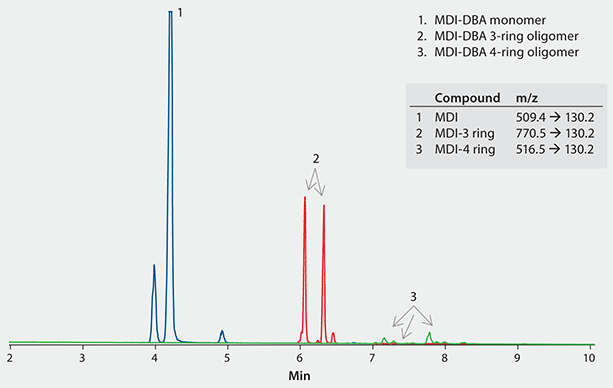
Polymeric-MDI (pMDI)
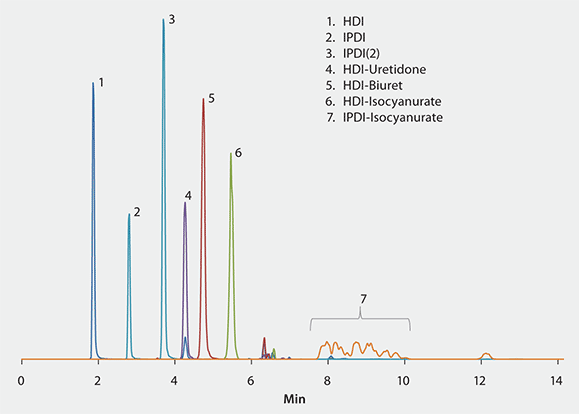
HDI and IPDI Adducts
TWA Sampling
Duplicate air samples were collected with different sampling times from an exposure chamber using the ASSET EZ4-NCO sampler. Isocyanate concentrations inside the exposure chamber were continuously generated to maintain constant concentrations using gas/liquid permeation technique. The sampling time is up to 10 hours (600 min) with linear response of the sampled amount; indicating the sampler has very high capacity and is very stable.
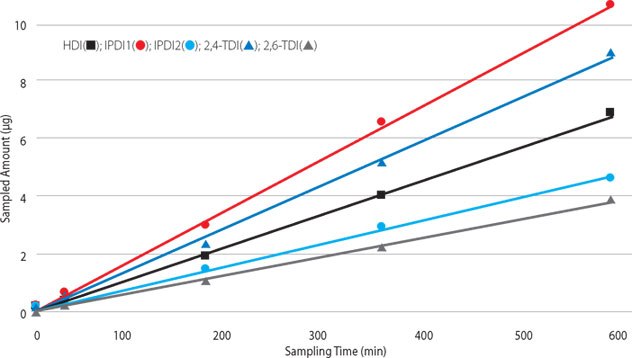
Correlation of Sampling Time with Amount of Sampled Isocyanate
Applications/Studies
Sampler technology protected by US Patent number US 7,700,045 B2; Apr. 20, 2010.
Methods:
ISO 17734-1:2013, Determination of Organonitrogen Compounds in Air Using Liquid Chromatography and Mass Spectrometry
Part 1: Isocyanates Using Dibutylamine Derivatives.
Part 2: Amines and Aminoisocyanates Using Dibutylamine and Ethyl Chloroformate Derivatives.
Authors: Gunnar Skarping, Marianne Dalene and Daniel Karlsson
In the following technical ISO report, the technology is described as the only methodology that covers all situations:
ISO/TR 17737:2012, Workplace Air - Guidelines for Selecting Analytical Methods for Sampling and Analyzing Isocyanates in Air
Authors: Gunnar Skarping, Marianne Dalene and Daniel Karlsson
Publications:
Isocyanates, Amines and Alkanolamines: Sampling, Chromatography and Detection
Author: Riddar, Jakob B,
Affiliation: Department of Analytical Chemistry, Faculty of Science, Stockholm University, P.O. Box 460, S-28124 Hassleholm, Sweden
Journal: Doctoral thesis, comprehensive summary (Other academic), 2013
Dry Sampling of Gas-Phase Isocyanates and Isocyanate Aerosols from Thermal Degradation of Polyurethane
Authors: Daniel Gylestam, Jakob B Riddar, Marianne Dalene and Gunnar Skarping
Affiliation: Department of Analytical Chemistry, Work Environment Chemistry, Stockholm University, P.O. Box 460, S-28124 Hassleholm, Sweden
Journal: Annals of Occupational Hygiene, 2013, Aug 9
Solvent-Free Sampling with Di-n-Butylamine for Monitoring of Isocyanates in Air
Authors: Asa Marand, Daniel Karlsson, Marianne Dalene and Gunnar Skarping
Affiliation: Department of Analytical Chemistry, Work Environment Chemistry, Stockholm University, P.O. Box 460, S-28124 Hassleholm, Sweden
Journal: Journal of Environmental Monitoring, 2005, 7, 335-343
Determination of Airborne Isocyanates as Di-n-Butylamine Derivatives Using Liquid Chromatography and Tandem Mass Spectrometry
Authors: Daniel Karlsson Jakob Dahlin, Asa Marand, Gunnar Skarping, Marianne Dalene
Affiliation: Department of Analytical Chemistry, Work Environment Chemistry, Stockholm University, P.O. Box 460, S-28124 Hassleholm, Sweden
Journal: Analytica Chimica Acta, 2005, 534, 263-269
Analytical Service Laboratories
Analytical Services available in Europe
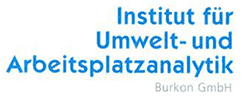
Institut für Umwelt- und Arbeitsplatzanalytik Burkon GmbH
Raudtener Straße 19b/21
90475 Nürnberg
Germany
Office
Phone 0911 / 834066
Fax 0911 / 98333344
E-mail info@ifu-burkon.de
Contact Dr. Bernd Seubert (b.seubert@ifu-burkon.de)
The Institut für Umwelt- und Arbeitsplatzanalytik Burkon GmbH (IfU Burkon GmbH) is an engineering company that specializes primarily in environmental and workplace measurements of chemical agents.
The company is also a testing laboratory both according to DIN EN ISO/IEC 17025 and § 29b Federal Immission Control Act (BImSchG). It was founded in 1987 in Nuremberg. Our qualified and experienced personnel consists of consulting engineers, chemical engineers, chemists and laboratory technicians. The laboratory equipment includes devices like LC-MS/MS, GC-MS, GC-FID, IC, HPLC, UV, AAS and others.
To study total business activities of IfU Burkon GmbH, please look at our web page (www.ifu-burkon.de).
We look forward to your inquiry and assure you an accurate and satisfying enforcement.

EHS Analytics AB
Visiting address/Delivery address:
EHS Analytics AB
Spånvägen 23
SE-245 34 Staffanstorp
Sweden
Contact: Mikael Adamsson
Phone: +46 704 58 55 61
E-mail: mikael.adamsson@ehs-analytics.com
EHS Analytics is a laboratory in southern Sweden specialized in the field of developing and providing state-of-the-art services, techniques and equipment for air sampling and monitoring, material testing and biological monitoring with a primary focus on isocyanates and related amines. EHS Analytics has renowned expertise in advanced analytical mass spectrometry techniques, built on decades of experience.
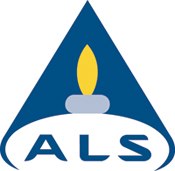
ALS Scandanavia AB
Rinkebyvägen 19c
SE-182 36 Danderyd
Sweden
Phone: +46-8-527 752 00
E-mail: info.ta@alsglobal.com
Homepage: https://www.alsglobal.se/en
ALS Scandinavia's laboratory in Täby focuses on particle and material analyses, physical-chemical water analyses and determination of organic compounds. We also have a close cooperation with other laboratories in the ALS family.
The head office is located in Luleå, while marketing and trade is run from Täby. We also have sales offices in Oslo, Copanhagen and Helsinki, and a sample drop off in Gothenburg.

Hall Analytical Laboratories Limited
Millbrook Business Centre
Floats Road Manchester M23 9YJ UK
Telephone: +44 (0)161 286 7889
Fax: +44 (0)161 286 7676
Email: info@hallanalytical.co.uk
Hall Analytical Laboratories specialises in providing a problem solving analytical service. The extensive range of mass spectrometric and chromatographic instrumentation combined with highly experienced and skilled scientists ensures that our clients can have the utmost confidence in the results.
GLP Statutory Instrument (1999, No. 3106)
GLP Statutory Instrument (2004, No. 994)
Analytical Services available in North America

960 West LeVoy Drive
Salt Lake City, UT 84123
Phone: 801-266-7700
Toll Free: 800-356-9135
Fax: 801-268-9992
www.alsglobal.com
Offers full analytical service for ASSET
ALS Environmental provides a broad range of sophisticated, state of the art testing services across the globe. As a leader of analytical chemistry, ALS is a diversified international laboratory group with locations in Australia, North America, South America, Africa, Asia, and Europe.
ALS Salt Lake City, formerly DataChem Laboratories, is a premier provider of industrial hygiene analytical services, delivering quality data to assist our clients in promoting human health. Accredited by the American Industrial Hygiene Council (AIHA) since 1974, we proudly served as the premier contract laboratory for the National Institute for Occupational Safety and Health for 32 years. ALS-SLC is NELAC accredited, providing environmental analytical services to government and private clientele such as the EPA, DoD and DOE, and numerous environmental engineering firms. In supporting environmental investigation and monitoring programs, ALS-SLC performs a full range of organic and inorganic analyses using SW-846 and EPA methodologies on a wide range of sample matrices including groundwater, surface water, wastewater, soil, sludge, and hazardous waste.
In addition, we provide analytical services to assist with the detection and removal efforts of site investigators, offering mycological, endotoxin, and bacterial analyses, including microbial culture techniques, spectrophotometry, microscopy, and GC/MS methodology, on a variety of sample matrices.
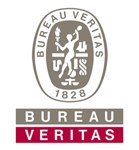
Bureau Veritas
Industrial Hygiene
22345 Roethel Drive
Novi, MI 48375
Phone: 248-344-1770
US (toll-free): 800-806-588
Fax: 248-344-2656
Email: LabonLine@us.bureauveritas.com
About Bureau Veritas: A global company specializing in the fields of Quality Assurance, Health, Safety, and Environmental (QHSE) services. With over 2,400 QHSE professionals in over 60 offices across North America, Bureau Veritas develops solutions that contribute to risk prevention and performance improvement to help organizations create long-term value through our technical and regulatory expertise. Bureau Veritas is present in 140 countries through a network of 900 offices and laboratories. It has more than 40,000 employees and a client base of more than 300,000.
We leverage our expertise in OSHA, ACGIH, NIOSH, ANSI, and other industry standards or guidelines to evaluate Industrial Hygiene procedures, policies, programs and potential exposures – developing relevant recommendations that protect your employees’ health while reducing redundancies, speeding projects, and reducing costs. We develop long-term strategies to assure continuous compliance, improve processes, and support of best management practices. With industry experience ranging from foundries to aerospace manufacturers and from small businesses to corporate giants, we can quickly pinpoint and deliver practical, client-specific solutions for a healthier workplace. By developing relationships with our clients that are based on trust, responsibility, technical expertise, and efficiency, Bureau Veritas provides effective solutions to emerging, immediate and long-term Industrial Hygiene issues.
Capabilities:
- ASSET EZ4-NCO Dry Sampler for Isocyanates
- Full Service Industrial Hygiene Analytical Service Provider
Analytical Services available in Australia & New Zealand
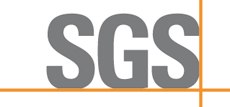
SGS Australia
Melbourne Office
10/585 Blackburn Rd Notting Hill, VIC, 3168, Australia
Phone: +61 (0)3 9574 3301; Mobile: 0407 058 050
Email: adam.atkinson@sgs.com
Website: www.au.sgs.com
SGS Australia offers analysis of the Supelco Asset EZ4-NCO dry sampler. Analysis is performed in our state-of-the-art Melbourne laboratory by LC/MS which provides sensitivity and specificity.
SGS Australia offers a range of specialised, high-tech, routine and non-routine analytical services. We have developed a reputation for quality and delivering results on the more difficult and complex projects in a wide range of sources including ambient air, stack sources, process streams and OH&S. SGS Australia other a extensive range of ISO17025 accredited analysis.
We have offices in Adelaide, Melbourne, Sydney and Brisbane, although we receive samples from all over the world. Access to leading edge technology and expertise in Australia and overseas guarantees results when you require them. Experience and multidisciplinary skills means our staff will provide you with an analytical solution. Specialised technical services, coupled with a willingness to tackle the more difficult and challenging projects ensures you will get results.
Trademarks
ASSET, Ascentis – Sigma-Aldrich Co. LLC.
ISO-CHEK is a registered trademark of Omega Specialty Instrument Co.
References
To continue reading please sign in or create an account.
Don't Have An Account?